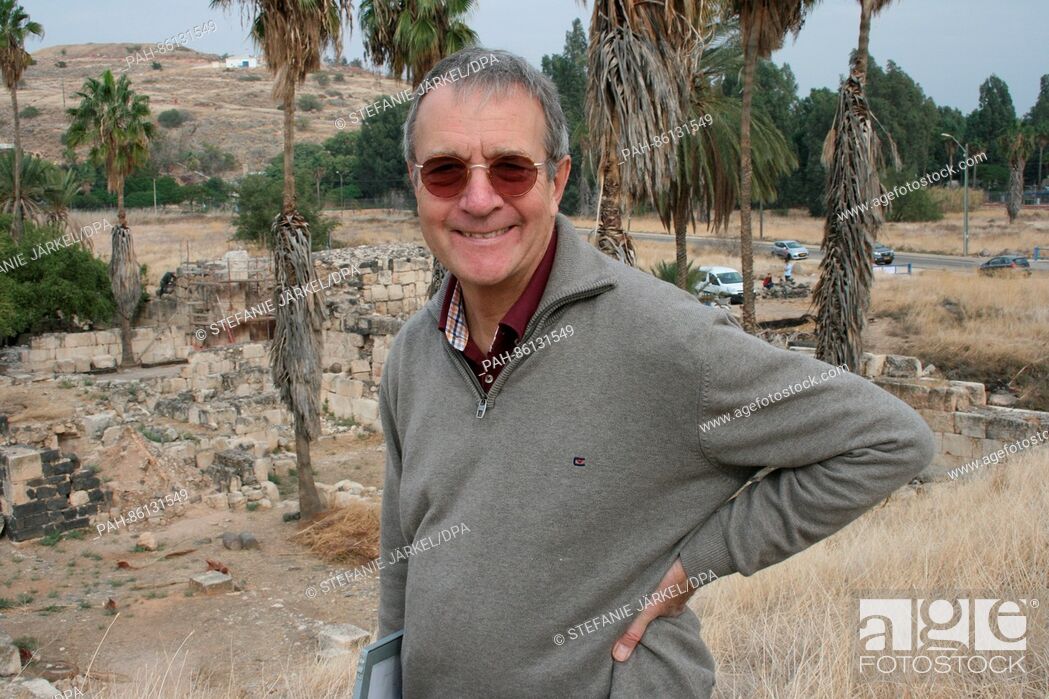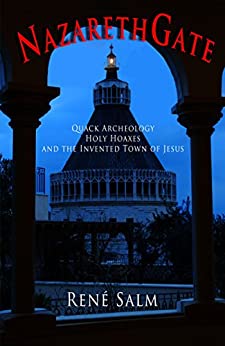
This post is an important and necessary follow up to my previous one about the falsehoods of O’Neill’s attacks on Salm’s work. Any readers with a serious interest in the dating of Nazareth and the seriousness of René Salm’s study of the archaeological record should be aware of the evidence that demonstrates how carelessly false Tim O’Neill’s public statements about his work really are.
Contrary to O’Neill’s assertions Salm did not mistranslate [my previous post demonstrated this by showing the locations of sites Kuhnen listed] or misinterpret Kuhnen as Kuhnen himself affirms in the following email exchange between Salm and Kuhnen and that I copy here with permission.
This first extract Kuhnen wrote initially to a third party but then copied to Salm himself. Bracketed clarifications are by Salm and the bolded highlighting is by me:
In my answer to Mr. Salm’s interesting question I referred to my Ph.D. thesis of 1982, published 1989 under the title “Studien zur Chronologie und Siedlungsarchäologie des Karmel (Israel) zwischen Hellenismus und Spätantike. Beihefte zum Tübinger Atlas des Vorderen Orients B 72 . Wiesbaden 1989. On pages 49 – 72 of this book you’ll find a chronological analysis of Hellenistic – Roman tombs excavated up to then in Palestine. My chronology is based primarily on internal evidence, i. e. the combination of finds, a method common in European prehistory, but up to now not yet introduced in Palestinian archaeology. My “comparing [comparison—RS] table of datable tombs” (Kombinationstabelle der Funde aus Gräbern”. Beilage 3) clearly proves that all kokim tombs of my “phase I”* (2nd [cent. BCE]- early 1st century AD) are concentrated in the Judean hills around Jerusalem. The earliest kokim tombs of Galilee appear in my “phase II”, starting around the middle of the 1st century AD. Therefore, from the evidence published up to the 1990s, Mr. Salm is right that there is no clear evidence of tombs of the period of Jesus in Nazareth.
… I definitely share your scepticism about the historicity of the New Testament. Last year I held a seminar and an excursion at the Institute of Biblical Archaeology of Mainz University on Holy places on the shore of the Lake of Galilee, which showed clearly that the localization of New Testament sites in Galilee is the work of Byzantine historiographers and not of the writers of the New Testament.* “Kombinationstabelle der Funde aus Gräbern” is the heading of Appendix 3 (“Beilage 3”) of Kuhnen’s PhD thesis. The heading literally means “Combination table of finds from tombs.” That’s of course quite different from Kuhnen’s translation. The word “Kombination” in German has inferences that the English “combination” lacks, including “comparison” (hence my bracketed clarification). The German “Tabelle” variously can mean many things: “table, list, chart, index, schedule, synopsis, summary” (from my large Cassell’s English & German dictionary). I ILL’ed Kuhnen’s thesis years ago and don’t have it at hand, but if … memory serves, the appendix in question is in the form of a list. So, I would translate the entire phrase as “Comparison list of finds from tombs”, or “Master list of finds from tombs”, or even “Master summary of finds from tombs.” Of course, we’re not talking about Nazareth finds here, but those in the vicinity of Mt. Carmel in Lower Galilee, about 30 km WNW of Nazareth. — RS.So , from an archaeological point of view, Salm’s arguments about a completely Judean “theatre” of NT history cannot be disregarded, but it seems to me that discussion will go on for a long time. [Jan . 4, 2010]
Here are a couple of further snippets from Kuhnen’s emails to Salm. They demonstrate that there has been no daylight (“misunderstanding”) between Kuhnen and Salm on tomb dating. Kuhnen even states that he considers Salm’s study sufficiently worthy to be included in his curriculum. (Unfortunately not every email has the date stamp preserved.) In the posts directly to Salm himself Kuhnen wrote in German but Salm has added translations:
– Kuhnen writes: “Hinsichtlich der Datierung der bekannten Gräber haben Sie sicher recht.” (“Regarding the dating of the known tombs [in Nazareth] you are certainly correct.” (Dated May 15, 2009)
– “Ihre Überlegungen sind sehr anregend, besonders Ihre Hauptthese, dass die Evangelien im wesentlichen die Realität nach dem Jahr 70 n. Chr. beschreiben. Auch Ihrer Einschätzung von Bagatti stimme ich zu. Er und einige andere seiner Kollegen (de Vaux, Humbert) sind meines Erachtens typische Vertreter einer kirchlichen Archäologie, die in der Archäologie das bestätigt sieht, was sie schon vorher wusste.” (“Your reflections are very exciting, particularly your main thesis that the gospels essentially describe the post-70 CE reality. I also agree with your estimation of Bagatti. He and some of his other colleagues (de Vaux, Humbert) are, in my opinion, typical apologists for an ecclesiastical archeology that simply confirms what it already knows.”
– “Insgesamt finde ich, wie gesagt , Ihre überlegungen sehr interessant, und habe darüber auch schon den Studenten in meinem derzeitigen Seminar an der Uni Mainz berichtet. Im nächsten Semester möchte ich an der Uni Mainz ein kritisches Seminar zum Thema “Archäologie und Neues Testament” anbieten. Dabei werden wir sicher auch Ihr Buch behandeln.” (Translation: “In all, I find your reflections very interesting, as mentioned above. I have already communicated your views to students in my current Seminar at the Univ. of Mainz. Next summer I would like to offer a critical seminar on the Archaeology of the New Testament. In it we will certainly discuss your book.” (Second half of May 2009.)
 I said in my previous post that contrary to the impression created by O’Neill Salm has engaged with Kuhnen’s work in considerable depth and most certainly was not “quote mining” a single sentence. Here is a list of all of Kuhnen’s works consulted by Salm from the bibliography of his second book, NazarethGate:
I said in my previous post that contrary to the impression created by O’Neill Salm has engaged with Kuhnen’s work in considerable depth and most certainly was not “quote mining” a single sentence. Here is a list of all of Kuhnen’s works consulted by Salm from the bibliography of his second book, NazarethGate:
Kuhnen, H-P.
1986. Nordwest-Palästina in hellenistisch-römischer Zeit. Bauten und Gräber im Karmelgebiet. Weinheim: VCH Verlag.
1989. Studien zur Chronologie und Siedlungsarchäologie des Karmel (Israel)
zwischen Hellenismus und Spätantike. (Tübinger Atlas zum Vorderen Orient. Beiheft B 72.) Wiesbaden.1990. Palästina in griechisch-römischer Zeit. (Handbuch der Archäologie. Vorderasien II,2.) München: C. H. Beck.
1994. Mit Thora und Todesmut: Judäa im Widerstand gegen die Römer von
Herodes bis Bar Kochba. (Führer und Bestandskataloge III.) Stuttgart: Württ. Landesmuseum .2002. “Bestattungswesen Palästinas im Hellenismus.” In: Die Religion in Geschichte und Gegenwart (Göttingen), pp. 211 f.
2007. “Grabbau und Bestattungssitten in Palästina zwischen Herodes und den Severern.” In: A. Faber, P. Fasold, M. Struck, M. Witteyer (Eds.), Körpergräber des 1.–3. Jh. in der römischen Welt. Kolloquium Frankfurt am Main 2004. Frankfurt: Schriften des Archäologischen Museums Frankfurt am Main, 57–76.
2009. (with W. Zwickel): Archäologie und Politik im Land der Bibel: 60 Jahre Gründung des Staates Israel. (Kleine Arbeiten zum Alten und Neuen Testament). Mainz: Spenner.
If you enjoyed this post, please consider donating to Vridar. Thanks!

I have replaced the Kuhnen bibliography that I originally included with this post. The first one went awry with OCR errors and contained numerous typos.
My personal hypothesis is that the city Called Nazareth in the New Testament is really Sepphoris. Matthew’s use of Isaiah 9 implies Nazareth to be in Zebulon not Issachar.
Sepphoris became the city’s name under Herod the Great, Nazareth I think was a name used during Herod Antipas administration that fell into disuse after his removal.